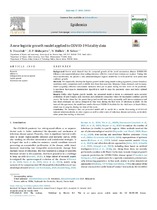| dc.contributor.author | Triambak, S | |
| dc.contributor.author | Mahapatra, D P | |
| dc.contributor.author | Mallick, N | |
| dc.contributor.author | Sahoo, R | |
| dc.date.accessioned | 2022-01-25T13:06:25Z | |
| dc.date.available | 2022-01-25T13:06:25Z | |
| dc.date.issued | 2021 | |
| dc.identifier.citation | Triambak, S., Mahapatra, D. P., Mallick, N., & Sahoo, R. (2021). A new logistic growth model applied to COVID-19 fatality data. Epidemics, 37 doi:10.1016/j.epidem.2021.100515 | en_US |
| dc.identifier.uri | doi:10.1016/j.epidem.2021.100515 | |
| dc.identifier.uri | http://hdl.handle.net/10566/7126 | |
| dc.description.abstract | follows a sub-exponential power-law scaling whenever effective control interventions are in place. Taking this
into consideration, we present a new phenomenological logistic model that is well-suited for such power-law
epidemic growth.
Methods: We empirically develop the logistic growth model using simple scaling arguments, known boundary
conditions and a comparison with available data from four countries, Belgium, China, Denmark and Germany,
where (arguably) effective containment measures were put in place during the first wave of the pandemic.
A non-linear least-squares minimization algorithm is used to map the parameter space and make optimal
predictions.
Results: Unlike other logistic growth models, our presented model is shown to consistently make accurate
predictions of peak heights, peak locations and cumulative saturation values for incomplete epidemic growth
curves. We further show that the power-law growth model also works reasonably well when containment and
lock down strategies are not as stringent as they were during the first wave of infections in 2020. On the
basis of this agreement, the model was used to forecast COVID-19 fatalities for the third wave in South Africa,
which was in progress during the time of this work.
Conclusion: We anticipate that our presented model will be useful for a similar forecasting of COVID-19
induced infections/deaths in other regions as well as other cases of infectious disease outbreaks, particularly
when power-law scaling is observed. | en_US |
| dc.language.iso | en | en_US |
| dc.publisher | Elsevier | en_US |
| dc.subject | COVID-19 | en_US |
| dc.subject | Subexponential power-law growth | en_US |
| dc.subject | Logistic growth | en_US |
| dc.subject | Non-linear least squares | en_US |
| dc.title | A new logistic growth model applied to COVID-19 fatality data | en_US |
| dc.type | Article | en_US |

